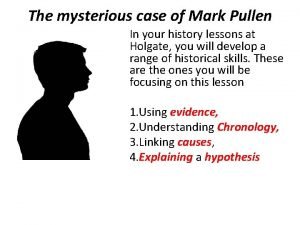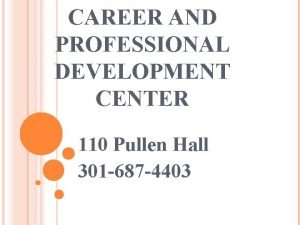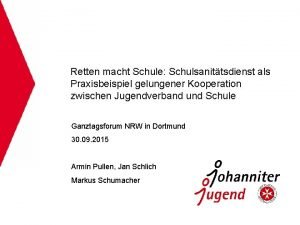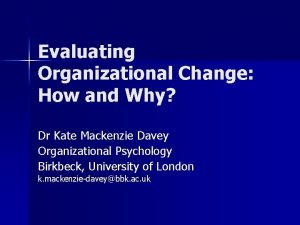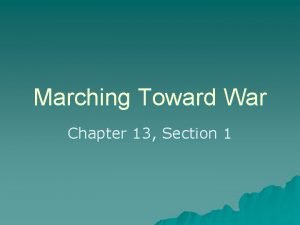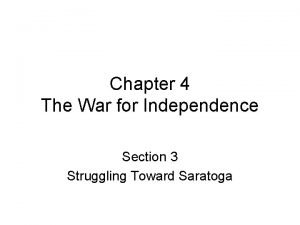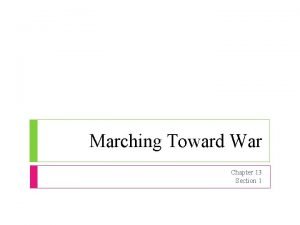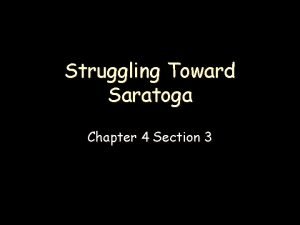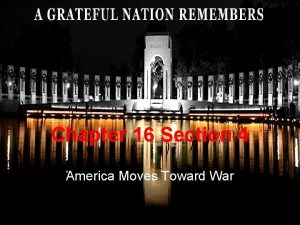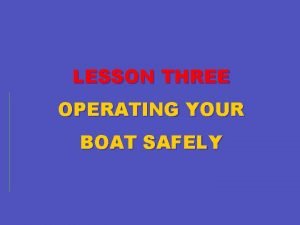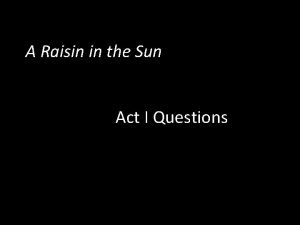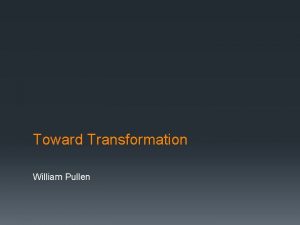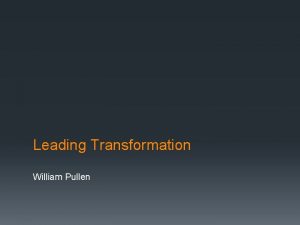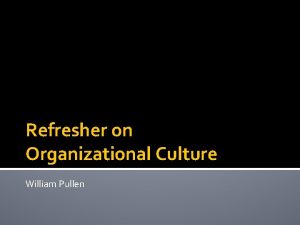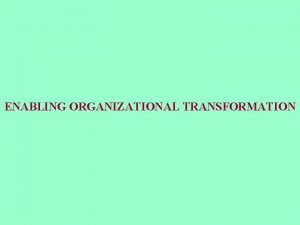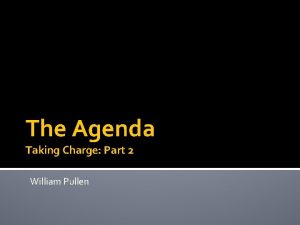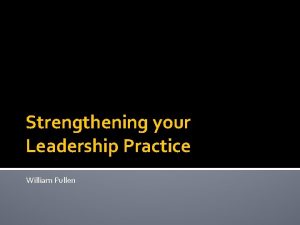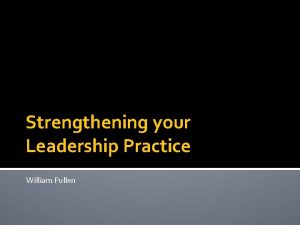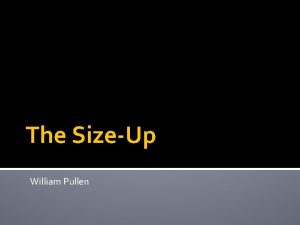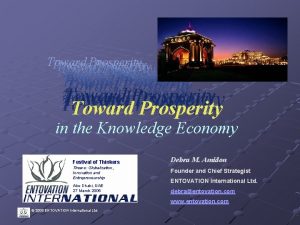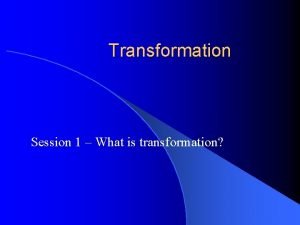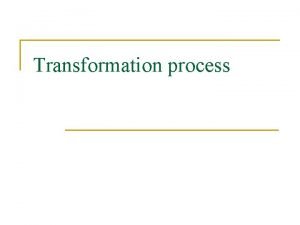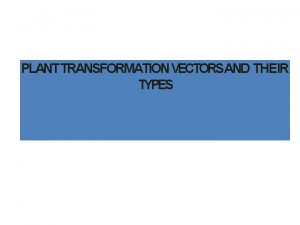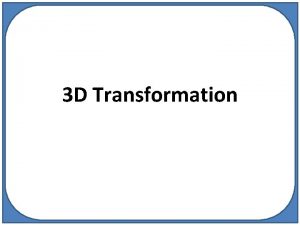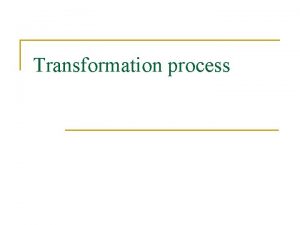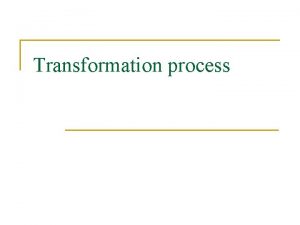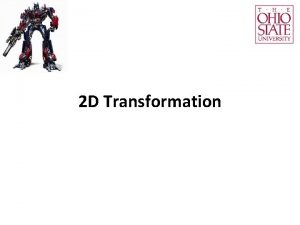Toward Transformation William Pullen 2 What is organizational




















- Slides: 20

Toward Transformation William Pullen

2 What is organizational transformation? § Recognition of a strategic shock/discontinuity: § Apparent disruption/step change in an external condition § Appearance of a new expectation for significantly different performance § Consequential implied change in fundamental business assumptions § Adaptation via an integrated strategy across at least three dimensions: § Top down execution of a new direction + cultural alignment § Cross-functional change in core processes § Bottom-up problem solving leading to performance improvement + cultural change § It is not large scale change to achieve efficiency or economic goals

3 Forces driving transformation § § § § § A significant evolution of the strategic environment (complexity, speed, volatility) Major disruptive external change (new stakeholders, new stakes, new issues) Perceived internal performance crisis relative to external pressures Resource pressures from broader systems/structures Appearance of a major new technology/process/system Ideology prompting radical adjustment in systems/structures Social demand for more entrepreneurial/innovative response Implied/real expectation for quantum performance change from stakeholders Greater external scrutiny, oversight and interdependency Response to new leadership/leadership change Safruddin & Recker, 2012 Mc. Nutt, 1993

4 Typology of Transformation External Perceptual Perceptible • Externally Visible • New Service • Negligible change to IT or Structure • Externally Visible • New Value Proposition • Significant change to IT & Structure Marginal Fundamental Suppositional Subliminal • Internally Visible • New Service • No change to IT & Structure • Internally Visible • New Value Proposition • Significant change to IT & Structure Most Frequent Internal Safruddin & Recker, 2012

5 What does transformed look like? § § § § § Different business model in use. New assumptions about work Greater integration between/among core functions & across boundaries Step changes in core functions, systems or processes More attuned/responsive to external events. Greater flexibility and agility Improved capacity to adapt to future shocks/discontinuities. More resilient. Reduction or removal of systemic performance barriers. Permeable boundaries Learning and development are apparent in major strategic decisions Increased repertoire of appropriate management and operational responses Different interpretations of core values. New values emerging. Culture aligned with new direction and sustained change in performance Mc. Kinsey, 1993

6 Tools for transformation 1. A sponsor who can provide cover and support 2. A guiding coalition to enable/enact transformation 3. Shared framework to structure responsibilities and assign activities 4. A road map laying out a proper sequence of activities, and; 5. A background set of guiding principles to govern transformation. Mc. Kinsey, 1993

7 #1: Sponsor § A credible senior executive § With status and standing in the culture. § An obvious personal stake in the future. § A network of external resources § Strong communication skills § A track record of (mostly) successful change.

8 #2: The Guiding Coalition § Represent key internal social networks: § § Authority (Chain of Command) Communications Problem solving Trust § The dominant coalition § Cultural exemplars and go-to’s (“They”) § Create/sustain the vision, road map and principles

9 #3: Transformational Framework: Integrated change in three axes Top-down direction setting and culture shaping Successful transformation usually has all three axes present in a balanced and integrated teambased transformation program Cross-functional core process change > culture change Bottom-up problem solving & performance improvement > culture change Mc. Kinsey, 1993

10 #3 A: Top down direction setting § Aim to create, shape and sustain conditions that enable transformation: § § § § § Shared development/ownership of a compelling vision (Guiding Coalition) A plan with limited performance targets and clear milestones linked to the vision Leadership agenda focused on sustained execution of the plan + communication Home-grown process change driven by plan and linked to vision Initiate an inclusive bottom-up process of performance improvement Comprehensive communications effort with feedback loops and measures Extensive use of human development to create/sustain momentum for change Multiple performance measures and benchmarks Concerted effort by leaders to clarify priorities, create energy, and signal commitment

11 #3 B: Bottom-up performance improvement § Harness the flywheel. Build momentum. Use a disciplined cyclical processes to close clearly identified performance gaps. Repeat Again. And again. § Engage the workforce in identifying problems preventing transformation § Focus on root causes and removing/reducing performance barriers in core processes § Begin at the smallest work unit practicable and scale up/across core functions § Front line operations focus on cost/quality/timeliness of service delivery § Staff operations focus on alignment and value-added support to front line § Management groups focus on performance opportunities § Connect performance barriers to the vision and share ownership of solutions § Build/strengthen a value for performance in the culture. Identify/use exemplars § Create and sustain momentum across cycles of performance improvement § Coordinate with changes in other two axes

12 #3 C: Cross-functional process change § Aim to shift the focus of work and decision making from vertical to horizontal across functions, locations, and organizational boundaries § Identify core organizational processes that add value and are unique to vision § Clean-sheet redesign of fundamental assumptions about how value is created § Incorporate change management built on skill development for new process § Link skill development to culture change initiatives § Create focused performance objectives for each core process § Aggressive communication of new values linked to vision. No doom loops! § Incorporate rigorous evaluation procedures and metrics § Integrate across processes and mutually reinforce § Coordinate with changes in other two axes

13 #4: Road map for transformation Phase 1: Vision & Direction Setting Phase 3: Process Design Phase 2: Performance Improvement Phase 4: Realignment Mc. Kinsey, 1993

14 #5: Guiding principles § § § § § Transformation is performance-based Build a cultural narrative for the (new) vision rooted in history Use numbers to align/measure/signal progress Strategy and structure remain important Teams are key building blocks/enablers. Build teams around leaders who have a personal stake in the future vision. Learning and development can drive transformation Process change must embody values Build critical mass through sequential and iterative methods Focus is essential

15 Critical success factors § Eyes on the prize. Stay focused on changing/improving performance. § Integrated effort. Work all three axes simultaneously and mutually reinforce. § Try for balanced emphasis across axes. Mitigate internal distortions/stresses. § Guiding coalition connected to teams with cross function membership. § Effective communication leading to cultural alignment and support § Think in terms of generations, not years.

16 Organizational Culture § Culture forms through the answers to 2 questions: § What is the work and how do we do it? § Who works here and how do we work together? § § § Culture is local and specific to a physical location Answers evolve over time and are continually tested/proven Leaders and exemplars maintain the narrative about the answers Organizational Change = changing the answers Organizational Transformation = new questions and new answers Schein, 1984

17 Transforming the culture § Understand the current questions and answers. § Review artifacts (documents, procedures, manuals, etc. ) § Talk to exemplars and go-to people § Observe the work and the work place § Change the questions and/or the way they are answered § Transactional: who works here and how do we work together? § Transformational: what is the (new) work and how do we do it?

18 Transforming the culture Cultural transformation is shaped/initiated by top-down direction setting (Vision) and enabled/sustained by bottom-up problem solving performance improvement and crossfunctional process change (Alignment & Engagement) Top-down direction setting (Vision) and culture shaping (Alignment) Cross-functional core process change (Alignment & Engagement) Bottom-up problem solving performance improvement (Alignment & Engagement)

19 Annex: Best practice propositions § § § § There is no silver bullet A tailored response improves the prospects of a successful transformation Transformation strategies emerging from history are more successful Strategies based on ideals work better than those based on goals Opportunities work better than threats in prompting transformation SWOT analysis can produce useful transformative agendas Strategies developed with stakeholders are more successful Strategies filtered through interest group preferences work better Mc. Nutt, 1993

20 Annex: Best practice propositions § § § Transformation strategies that use development are more apt to be successful Innovation is more likely to produce transformation Coordination based on ideals and values trumps other methods of control Leadership makes a difference. Empowerment and positive energy are key Leaders who can remove barriers are more likely to produce transformation Leaders who enable independent actions are more likely to transform Mc. Nutt, 1993
 What happened to mark pullen
What happened to mark pullen Pullen hall
Pullen hall Armin pullen
Armin pullen East herts lottery
East herts lottery Evaluating organizational change
Evaluating organizational change Marching toward war chapter 13 section 1
Marching toward war chapter 13 section 1 What is the attitude of the narrator toward rachel/rachelle
What is the attitude of the narrator toward rachel/rachelle Chapter 4 section 3 struggling toward saratoga
Chapter 4 section 3 struggling toward saratoga Chapter 29 section 1 marching toward war
Chapter 29 section 1 marching toward war Chapter 13 marching toward war
Chapter 13 marching toward war Struggling toward saratoga section 3
Struggling toward saratoga section 3 The metamorphosis activities
The metamorphosis activities How does the narrator convey a mixed attitude toward gatsby
How does the narrator convey a mixed attitude toward gatsby America moves toward war section 4
America moves toward war section 4 Oag: toward linking large-scale heterogeneous entity graphs
Oag: toward linking large-scale heterogeneous entity graphs Environmental science toward a sustainable future
Environmental science toward a sustainable future Toward civil war lesson 3 secession and war
Toward civil war lesson 3 secession and war Casting off with wind toward dock
Casting off with wind toward dock A spar attached to the of a mast running athwart ship
A spar attached to the of a mast running athwart ship Raisin in the sun questions
Raisin in the sun questions Chapter 19 drifting toward disunion
Chapter 19 drifting toward disunion
